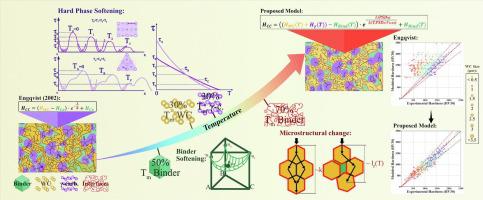当前位置:
X-MOL 学术
›
Int. J. Refract. Met. Hard Mater.
›
论文详情
Our official English website, www.x-mol.net, welcomes your
feedback! (Note: you will need to create a separate account there.)
Microstructural stability of cemented carbides at high temperatures: Modeling the effect on the hot hardness
International Journal of Refractory Metals & Hard Materials ( IF 4.2 ) Pub Date : 2024-07-19 , DOI: 10.1016/j.ijrmhm.2024.106805 V. Lamelas , M. Bonvalet Rolland , M. Walbrühl , A. Borgenstam
International Journal of Refractory Metals & Hard Materials ( IF 4.2 ) Pub Date : 2024-07-19 , DOI: 10.1016/j.ijrmhm.2024.106805 V. Lamelas , M. Bonvalet Rolland , M. Walbrühl , A. Borgenstam

|
There are several semi-empirical models available in literature that correlate the intrinsic hardness of cemented carbides' constitutive phases and certain microstructural parameters, such as mean WC grain size and Co volume fraction, with the hardness of the cemented carbide. Nonetheless, such empirical relations fall short on predicting the behavior of materials other than WC-Co which they were fitted to, limiting their applicability on materials with diverse particle size distributions, alternative binder systems or with additional carbides (γ-carbides). Additionally, current models are limited to the prediction of room temperature hardness. Framed in an Integrated Computational Materials Engineering (ICME) approach, this work proposes several models to be integrated into an already validated semi-empirical approach to describe the hardness of cemented carbides as a function of temperature. First, new microstructural descriptors on the particle and binder size distributions are proposed to enable a better understanding of the influence of polydispersity and of the addition of γ-carbides on the hard-to-soft phase reinforcement. Second, a validated Peierls-Nabarro-based model is used to describe the intrinsic softening of the hard phases with temperature. And finally, the importance of the microstructural changes happening under stress at high temperatures is highlighted and its effect on hot hardness is introduced into the model. These upgrades increase the theoretical and physical base of the modeling tool providing a physical meaning to all the modeling parameters, lowering the need for numerical fitting, making the model more generic and bringing additional information into the micromechanics involved in the softening of cemented carbides.
中文翻译:

高温下硬质合金的微观结构稳定性:模拟对热硬度的影响
文献中有几种半经验模型,它们将硬质合金本构相的固有硬度和某些微观结构参数(例如平均 WC 晶粒尺寸和 Co 体积分数)与硬质合金的硬度相关联。尽管如此,这种经验关系在预测除 WC-Co 以外的材料的行为方面还不够,限制了它们在具有不同粒度分布、替代粘合剂系统或具有附加碳化物(γ-碳化物)的材料上的适用性。此外,当前模型仅限于预测室温硬度。这项工作以综合计算材料工程(ICME)方法为框架,提出了几个模型,将其集成到已经验证的半经验方法中,以描述硬质合金的硬度作为温度的函数。首先,提出了关于颗粒和粘合剂尺寸分布的新微观结构描述符,以便更好地理解多分散性和γ-碳化物的添加对硬到软相增强的影响。其次,使用经过验证的 Peierls-Nabarro 模型来描述硬质相随温度的内在软化。最后,强调了高温应力下发生的微观结构变化的重要性,并将其对热硬度的影响引入到模型中。这些升级增强了建模工具的理论和物理基础,为所有建模参数提供了物理意义,降低了数值拟合的需要,使模型更加通用,并将更多信息引入了硬质合金软化所涉及的微观力学中。
更新日期:2024-07-19
中文翻译:

高温下硬质合金的微观结构稳定性:模拟对热硬度的影响
文献中有几种半经验模型,它们将硬质合金本构相的固有硬度和某些微观结构参数(例如平均 WC 晶粒尺寸和 Co 体积分数)与硬质合金的硬度相关联。尽管如此,这种经验关系在预测除 WC-Co 以外的材料的行为方面还不够,限制了它们在具有不同粒度分布、替代粘合剂系统或具有附加碳化物(γ-碳化物)的材料上的适用性。此外,当前模型仅限于预测室温硬度。这项工作以综合计算材料工程(ICME)方法为框架,提出了几个模型,将其集成到已经验证的半经验方法中,以描述硬质合金的硬度作为温度的函数。首先,提出了关于颗粒和粘合剂尺寸分布的新微观结构描述符,以便更好地理解多分散性和γ-碳化物的添加对硬到软相增强的影响。其次,使用经过验证的 Peierls-Nabarro 模型来描述硬质相随温度的内在软化。最后,强调了高温应力下发生的微观结构变化的重要性,并将其对热硬度的影响引入到模型中。这些升级增强了建模工具的理论和物理基础,为所有建模参数提供了物理意义,降低了数值拟合的需要,使模型更加通用,并将更多信息引入了硬质合金软化所涉及的微观力学中。











































 京公网安备 11010802027423号
京公网安备 11010802027423号